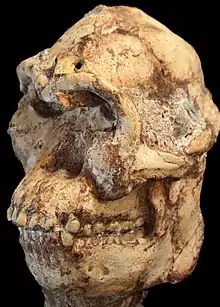Nomen nudum
In taxonomy, a nomen nudum ('naked name'; plural nomina nuda) is a designation[2] which looks exactly like a scientific name of an organism, and may have originally been intended to be one, but it has not been published with an adequate description. This makes it a "bare" or "naked" name, which cannot be accepted as it stands.[3] A largely equivalent but much less frequently used term is nomen tantum ("name only"). Sometimes, "nomina nuda" is erroneously considered a synonym for the term "unavailable names". However, not all unavailable names are nomina nuda.[4]

In zoology
According to the rules of zoological nomenclature a nomen nudum is unavailable; the glossary of the International Code of Zoological Nomenclature gives this definition:[5]
nomen nudum (pl. nomina nuda), n.
A Latin term referring to a name that, if published before 1931, fails to conform to Article 12; or, if published after 1930, fails to conform to Article 13. […]
And among the rules of that same Zoological Code:
12.1. To be available, every new name published before 1931 must … be accompanied by a description or a definition of the taxon that it denotes, or by an indication [that is, a reference to such a description or definition]. …
13.1. To be available, every new name published after 1930 must … be accompanied by a description or definition that states in words characters that are purported to differentiate the taxon, or be accompanied by a bibliographic reference to such a published statement.
In botany
According to the rules of botanical nomenclature a nomen nudum is not validly published. The glossary of the International Code of Nomenclature for algae, fungi, and plants gives this definition:[6]
A designation of a new taxon published without a description or diagnosis or reference to a description or diagnosis.
The requirements for the diagnosis or description are covered by articles 32, 36, 41, 42, and 44.[6]
Nomina nuda that were published before 1 January 1959 can be used to establish a cultivar name. For example, Veronica sutherlandii, a nomen nudum, has been used as the basis for Hebe pinguifolia 'Sutherlandii'.[7]
References
- Berger, Lee R.; Hawks, John (14 December 2018). "Australopithecus prometheus is a nomen nudum". American Journal of Biological Anthropology. 168 (2): 383–387. doi:10.1002/ajpa.23743. ISSN 2692-7691. PMID 30552667. S2CID 54582416. Retrieved 24 October 2023.
- Turland, N. (2013). The Code Decoded: A user's guide to the International Code of Nomenclature for algae, fungi, and plants. Vol. Regnum Vegetabile Volume 155. Koeltz Scientific Books. ISBN 978-3-87429-433-1.
- "What is a nomen nudum?". International Commission on Zoological Nomenclature. Retrieved 11 September 2010.
- Caetano, João Marcus Vale; Delcourt, Rafael & Ponciano, Luiza Corral Martins de Oliveira (March 2023). "A taxon with no name: 'Ubirajara jubatus' (Saurischia: Compsognathidae) is an unavailable name and has no nomenclatural relevance". Zootaxa. 5254 (3): 443–446. doi:10.11646/zootaxa.5254.3.10. PMID 37044710. S2CID 257500264.
- International Commission on Zoological Nomenclature. "Glossary". International Trust for Zoological Nomenclature. Retrieved 11 September 2010.
- MlepwcNeill, J.; Barrie, F.R.; Buck, W.R.; Demoulin, V.; Greuter, W.; Hawksworth, D.L.; Herendeen, P.S.; Knapp, S.; Marhold, K.; Prado, J.; Prud'homme Van Reine, W.F.; Smith, G.F.; Wiersema, J.H.; Turland, N.J. (2012). International Code of Nomenclature for algae, fungi, and plants (Melbourne Code) adopted by the Eighteenth International Botanical Congress Melbourne, Australia, July 2011. Vol. Regnum Vegetabile 154. A.R.G. Gantner Verlag KG. ISBN 978-3-87429-425-6.
- Brickell, C.D.; Alexander, C.; David, J.C.; Hetterscheid, W.L.A.; Leslie, A.C.; Malecot, V.; Jin, X.; Cubey, J.J. (2009), International Code of Nomenclature for Cultivated Plants (ICNCP or Cultivated Plant Code) incorporating the Rules and Recommendations for naming plants in cultivation, Eighth Edition, Adopted by the International Union of Biological Sciences International Commission for the Nomenclature of Cultivated Plants (PDF), International Association for Plant Taxonomy and International Society for Horticultural Science, ISBN 978-90-6605-662-6 Article 21.6